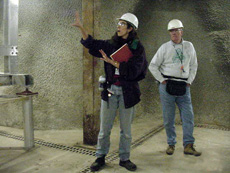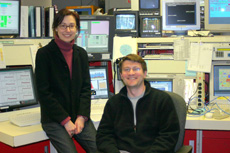|
Thurs., November 30
2:30 p.m. Theoretical Physics Seminar - Curia II
Speaker: Z. Ligeti, Lawrence Berkeley National Laboratory
Title: Squeezing Blood from a Stone: Shapes of b--> sl+l-
4:00 p.m. Town Hall Meeting - HEPAP High Energy Physics University Grants Program Subpanel - 1 West
THERE WILL BE NO ALCPG ILC PHYSICS AND DETECTOR
SEMINAR THIS WEEK
THERE WILL BE NO DIRECTOR'S COFFEE BREAK TODAY
THERE WILL BE NO ACCELERATOR PHYSICS AND
TECHNOLOGY SEMINAR TODAY Fri., December 1
3:30 p.m. Director's Coffee Break - 2nd floor crossover
Joint Experimental Theoretical Physics Seminar -
1 West
Topic: To Be Announced
4:00 p.m. Joint Experimental Theoretical Physics Seminar - 1 West
Speaker: B. Stelzer, University of California, Los Angeles
Title: Status of Single Top Analysis on CDF
8:00 p.m. Arts and Lectures Series - Auditorium - $5
Speaker: D. Harris
Title: Neutrino Beams at Fermilab: The Fastest Way Between Here and Minnesota
Click here for NALCAL,
a weekly calendar with links to additional information. |
Thursday, November 30
-Southwestern Chicken Tortilla
-Philly Style Cheese Steak
-Garlic Herb Roasted Pork
-Tomato Basil Chicken Parmesan
-Southwestern Turkey Wrap
-Assorted Slice Pizza
-Marinated Grilled Chicken Caesar Salad
Wilson Hall Cafe Menu |
|
Thursday, November 30
Dinner
French Onion Soup
Filet Mignon with Espagnole Sauce
Potato Gratin
Vegetable of the Season
Brandy Flan
Wednesday, December 6
Lunch
Catfish Fillet with Coarse Mustard Sauce
Roasted Corn and Red Pepper
Tomato Rice Pilaf
Chocolate Pecan Tart
Chez Leon Menu
Call x4598 to make your reservation. |
|
|
Harris will discuss production and detection of neutrinos

Deborah Harris giving a tour of the NuMI Beamline. She will talk about
neutrino experiments on Friday as part of the Arts and Lectures series.
Photograph courtesy of Al Elste.
Neutrinos have the
curious ability to transform themselves, or oscillate, from one type to
another for reasons that we are still discovering. In order to look for
these oscillations, physicists have had to build
some very impressive tools. One such tool is Fermilab's NuMI beamline, which
accepts about 200 vacuum cleaners' worth of power in the form of a
millimeter-diameter proton beam, and as a result, sends billions of neutrinos
per second to Northern Minnesota. In her talk on Friday, Dr. Harris will
describe both the beamlines at Fermilab that produce neutrinos and the detectors (near and
far) that see them.
Deborah Harris has been a Staff Scientist at Fermilab since 1999 and has
been involved with several different Fermilab experiments starting as a graduate student
in 1990. She is on three neutrino experiments, spending most of her time as Project Manager
of the upcoming neutrino experiment MINERvA.
The lecture will begin at 8 p.m. this Friday, December 1 in Fermilab's
Ramsey Auditorium. Cost is $5.00. For information, call 630-840-ARTS
(630-840-2787). |
|

10 Year Service Award:
Front (from left): Stanley Naymola, Denise Finstrom and Timothy Kasza;
Back: Robert Kennedy, Michael Michalak, Marcela Carena, Gustavo Cancelo and Bruce Chrisman (Directorate).

20 Year Service Award:
Lauri Loebel Carpenter, Michael Church, Diana Bonham and Bruce Chrisman (Directorate).

30 Year Service Award:
Front (from left): Gary Sliwicki, Laura Sedlacek and Gianni Tassotto;
Back: Gregory Saewert, Lauren Jones, Richard Kujath and Bruce Chrisman (Directorate).

35 Year Service Award:
Front (from left): Roy Mraz Jr., Jawahar Ticku and Rupert Crouch;
Back: Thomas Baird, Kenneth Schultz, Robert Angstadt, John Reid and Bruce Chrisman (Directorate).
|
FYI The AIP Bulletin of Science Policy News,
November 29, 2006:
Findings from the New S&T Benchmark Report
Earlier this month, The Task Force on the Future of American Innovation released "Measuring the Moment: Innovation, National Security, and Economic Competitiveness. Benchmarks of our Innovation Future II." The following are selections from this report; the complete document can be read online.
"This outpouring of [S&T/competitiveness] reports from a broad range of interests has shaped the public debate. Certainly the American people are convinced. A strong majority believes the country needs to invest more in basic research. For example, a national survey conducted by Public Opinion Strategies and commissioned by this task force showed that 70 percent of the public supports increasing federal funding by 10 percent a year for the next seven years for university research in science and engineering. The same survey shows that 49 percent of the electorate believes America's ability to compete economically in the world has grown worse over the past few years. This number is up from 38 percent in 1991."
Read More |
|
|
A super solution to
a massive problem

Upper limits on neutral SUSY-Higgs boson production rates as a function of Higgs boson mass. Results are shown for bH associated production and for both H → ττ and H → bb decays.
The Standard Model, a modern theory of elementary particles and their interactions, has had a "massive" problem for many years. It desperately needs a physical mechanism to explain the origin of particle masses. The easiest solution (using just one Higgs boson) is looking a bit worrisome because it may not be able to maintain consistency over a vast range of precision measurements and theoretical predictions. Fortunately, another theory called Supersymmetry (or SUSY) might provide some welcome relief.
The Standard Model arises from symmetries in nature that lead to conservation laws (eg, conservation of energy or momentum). SUSY introduces a new symmetry between fermions and bosons that predicts several new particles, including five Higgs bosons (three neutral, two charged). These new particles would give the Standard Model much more leeway to maintain agreement with existing measurements, while still generating the much-needed particle masses. Furthermore, SUSY predicts that the neutral Higgs bosons could be produced along with b-quarks at a rate observable at the Tevatron collider.
The neutral SUSY-Higgs particles themselves usually decay into pairs of b-quarks or tau-leptons. Although final states with at least three b-quarks have been extensively explored at the Tevatron (Result of the Week, April 14, 2005), the case of SUSY-Higgs bosons produced with b-quarks and decaying into tau-leptons has never before been studied. The DZero collaboration has recently pioneered such a search, requiring one tau to decay hadronically and the other into a muon. The search results were consistent with the expectations from Standard Model backgrounds, and an upper limit on the production rate of neutral SUSY-Higgs bosons was set.
By combining the limits from the bH→bττ (where "τ" stands for "tau") and b(b)H→(b)bb final states and the limit of inclusive H → ττ production (ROW May 11, 2006), DZero has significantly extended the limits on possible SUSY parameters. As data pours in from the Tevatron each day, you can rest assured that DZero is keeping a close eye out for a supersymmetric solution for the Standard Model's "massive" problem.

Above: Anna Goussiou, Peter Svoisky, and Yury Pogorelov (not pictured) made significant contributions to this analysis. Below: The strong efforts of the DZero tau-lepton identification group helped ensure the success of this analysis and all analyses that search for tau-leptons. Top row, from left: Federique Badaud, Catherine Biscarat, Cristina Galea, Philipe Gris and Mark Owen.
Bottom row, from left: Abid Patwa, Serban Protopopescu, Philip Rich and Peter Svoisky.

|
Benefits enrollment ends soon
Have you completed your 2007 flexible spending account enrollment? Enrollment ends today, November 30. This is your opportunity to put aside pre-tax dollars for eligible healthcare and dependent care expenses. Enrollment materials are available on the Benefits Department web page or in the Benefits Office.
International Folk Dancing
International Folk Dancing will meet today, November 30, at Kuhn Barn. Dancing begins at 7:30 p.m. with teaching and children's dances earlier in the evening and request dancing later on. Newcomers are welcome and you do not need to come with a partner. Info at 630-584-0825 or 630-840-8194 or folkdance@fnal.gov.
English country dancing
English country dancing will meet at 2 p.m. Sunday, December 3, at Kuhn Barn. Newcomers are most welcome and you don't need to come with a partner. The group will continue meeting the first Sunday afternoon of the month. For more information please contact folkdance@fnal.gov or call 630-584-0825 or 630-840-8194.
Upcoming Activities |
|